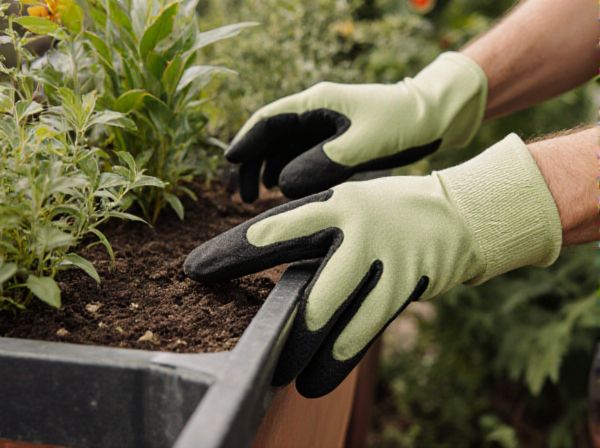
Container gardening vs hydroponic container gardening Illustration
Container gardening allows gardeners to grow plants in portable pots using soil, offering flexibility and natural nutrient cycling. Hydroponic container gardening eliminates soil by using nutrient-rich water solutions, promoting faster growth and higher yields in limited spaces. Both methods optimize space, but hydroponics requires more control over environmental factors for successful plant development.
Table of Comparison
| Aspect | Container Gardening | Hydroponic Container Gardening |
|---|---|---|
| Growing Medium | Soil-based | Water-based nutrient solution |
| Water Usage | Higher, dependent on soil moisture | Lower, recirculated water system |
| Growth Rate | Standard plant growth speed | Up to 25-50% faster growth |
| Space Efficiency | Moderate, requires more soil volume | High, compact setup with controlled environment |
| Maintenance | Regular watering, soil care, pest control | System monitoring, nutrient management, pH control |
| Pest and Disease Risk | Higher due to soil pathogens | Lower risk, controlled medium |
| Cost | Low initial setup, moderate ongoing costs | Higher initial investment, lower long-term costs |
| Plant Types | Suitable for most plants | Best for leafy greens, herbs, and vine crops |
Understanding Container Gardening: Traditional Methods
Traditional container gardening involves growing plants in soil-filled pots or containers, utilizing soil's natural nutrients and microbes to support plant growth. Common containers include plastic, clay, or ceramic pots, which provide root aeration and drainage essential for healthy development. This method requires regular watering, fertilizing, and pest management to maintain plant health and productivity.
Introduction to Hydroponic Container Gardening
Hydroponic container gardening involves growing plants in nutrient-rich water solutions without soil, optimizing space and resource use. This method enhances growth rates and yields by delivering precise nutrients directly to plant roots within controlled containers. Compared to traditional container gardening, hydroponic systems reduce water consumption and eliminate soil-borne diseases, contributing to more sustainable urban agriculture.
Key Differences: Soil vs. Soilless Growing
Container gardening uses soil as the growing medium, providing natural nutrients and microbial life essential for plant health. Hydroponic container gardening relies on a soilless system, utilizing nutrient-rich water solutions to deliver minerals directly to plant roots. This key difference affects watering frequency, nutrient management, and plant growth speed, with hydroponics often enabling faster growth and higher yields due to optimized nutrient delivery.
Space Efficiency: Which Method Saves More Room?
Container gardening utilizes soil-filled pots or beds that often require more space due to root expansion and drainage needs, making it less space-efficient for compact areas. Hydroponic container gardening uses nutrient-rich water solutions in stacked or vertical systems, significantly maximizing space by allowing higher plant density and multi-layer setups. Vertical hydroponic containers save up to 70% more space compared to traditional soil-based containers.
Water Usage: Conservation and Efficiency Compared
Container gardening typically requires frequent watering due to soil evaporation and drainage, often leading to higher water consumption. Hydroponic container gardening utilizes recirculating water systems that minimize waste by delivering nutrients directly to plant roots, significantly increasing water use efficiency. Studies show hydroponic setups can reduce water usage by up to 90% compared to traditional container gardening, making them ideal for sustainable urban agriculture.
Nutrient Management: Organic vs. Synthetic Fertilizers
Container gardening relies heavily on organic fertilizers that enrich soil with natural nutrients, promoting microbial activity and sustainable growth. Hydroponic container gardening uses synthetic nutrient solutions precisely balanced for optimal plant uptake and faster growth rates. Effective nutrient management in hydroponics requires monitoring pH and electrical conductivity, while organic container gardening depends on the gradual nutrient release and soil health maintenance.
Plant Variety: What Grows Best in Each System?
Container gardening offers a wide range of plant variety including herbs, flowers, and vegetables like tomatoes and peppers that thrive in soil-based environments. Hydroponic container gardening excels with leafy greens such as lettuce, spinach, and kale, as well as strawberries and herbs, benefiting from the controlled nutrient delivery system. Each method supports specific plant types optimized for growth conditions; soil containers favor root vegetables while hydroponics boost fast-growing, water-loving plants.
Startup Costs and Maintenance Requirements
Container gardening typically requires lower startup costs, involving basic supplies like soil, pots, and seeds, whereas hydroponic container gardening demands a higher initial investment in equipment such as pumps, grow lights, and nutrient solutions. Maintenance for traditional container gardening centers around regular watering and soil care, while hydroponic systems require careful monitoring of pH levels, nutrient balance, and system cleanliness to prevent malfunctions. Hydroponic setups offer faster growth rates but involve more technical skill and ongoing system management compared to conventional container gardening.
Pest and Disease Management in Both Systems
Container gardening and hydroponic container gardening both require vigilant pest and disease management to ensure healthy plant growth. Soil-based container gardening often faces challenges from soil-borne pests and diseases such as root rot and fungal infections, necessitating regular monitoring and organic or chemical treatments. Hydroponic container systems reduce soil-related issues but are susceptible to waterborne pathogens and algae, making water quality management and sterilization practices critical for preventing infestations and disease outbreaks.
Sustainability and Environmental Impact
Container gardening utilizes soil and natural compost, promoting biodiversity and organic nutrient cycling, whereas hydroponic container gardening minimizes water usage by up to 90% and reduces the need for chemical fertilizers, significantly lowering runoff pollution. Hydroponic systems often use recyclable or reusable containers, decreasing plastic waste and offering precise resource management that can reduce carbon footprints. Both methods encourage urban greening, but hydroponic container gardening presents a more sustainable option by optimizing resource efficiency and limiting environmental degradation.
Container gardening vs hydroponic container gardening Infographic

 gardendif.com
gardendif.com